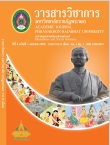แนวทางการบริหารการพัฒนาทรัพยากรมนุษย์ สำหรับการจัดการเพื่อความมั่นคงและสมรรถนะ ในการบรรลุวิสัยทัศน์ของสถาบันการเงิน: กรณีธนาคารเพื่อการเกษตรและสหกรณ์การเกษตร
Keywords:
การบริหารการพัฒนาทรัพยากรมนุษย์, ธนาคารเพื่อการเกษตรและสหกรณ์การเกษตร (ธ.ก.ส.), คุณภาพชีวิตของเกษตรกร, Human resource development administration, The Bank for Agriculture and Agricultural Cooperatives, BAAC, Quality of agriculturists’ livesAbstract
การศึกษาครั้งนี้มีวัตถุประสงค์เพื่อศึกษาปัจจัย เกี่ยวกับการบริหารการพัฒนาทรัพยากรมนุษย์และ การจัดการ โดยศึกษาความเชื่อมโยงของปัจจัยเป็นตัว แบบสำหรับใช้ในการกำหนดแนวทางการบริหารการ พัฒนาทรัพยากรมนุษย์และการจัดการของธนาคารเพื่อ การเกษตรและสหกรณ์การเกษตร (ธ.ก.ส.) อันจะนำไป สู่ความมั่นคงและความสามารถในการบรรลุวิสัยทัศน์ ขององค์การคือการช่วยพัฒนายกระดับคุณภาพชีวิตของเกษตรกร
ผลการศึกษาที่อาศัยเทคนิคการวิเคราะห์ ปัจจัย การวิเคราะห์เส้นทาง และการวิเคราะห์ถดถอย พบว่าปัจจัยสำคัญที่ส่งผลต่อการพัฒนาคุณภาพชีวิต ของเกษตรกรประกอบด้วย 16 ปัจจัยซึ่งมีโครงสร้าง ความสัมพันธ์ระหว่างปัจจัยเป็นตัวแบบเส้นทาง (Path Analysis Model) และยังพบอีกว่าเจตคติของพนักงาน ธ.ก.ส.ในการมุ่งพัฒนาคุณภาพชีวิตของเกษตรกร สามารถส่งผลต่อการเพิ่มทรัพย์สินของเกษตรกร นอกจากนี้พบอีกว่าในพื้นที่ภาคที่พนักงาน ธ.ก.ส. มี เจตคติในการมุ่งพัฒนาคุณภาพชีวิตเกษตรกรสูง ได้ส่งผลให้เกษตรกรในพื้นที่ภาคดังกล่าวมีรายได้สูงขึ้นตาม ไปด้วย
การค้นพบดังกล่าวนำไปสู่ข้อสรุปว่า การบรรลุ ผลตามวิสัยทัศน์และภารกิจของ ธ.ก.ส. เกิดจากเหตุ หลายปัจจัยที่มีความสัมพันธ์แบบเส้นทาง ทุกเหตุปัจจัย ส่งผลทั้งทางตรงและทางอ้อมต่อการบรรลุคุณภาพชีวิต ของเกษตรกรซึ่งเป็นเป้าหมายสูงสุดตามวิสัยทัศน์และภารกิจ อีกทั้งเจตนารมณ์ในการก่อตั้ง ธ.ก.ส. ตลอดจน ความคาดหวังของรัฐบาลและสังคมไทย
A Human Resource Development Administration Approach for Stability and Competency to Achieve the Financial Institution’s Vision: The Case of Bank for Agriculture and Agricultural Cooperatives (BAAC)
The purpose of this research was to study factors and relationships among these factors to be used as a model for determining strategies of human resource development administration and management of the Bank for Agriculture and Agricultural Cooperatives: BAAC. which led to the stability and competency to achieve the organization’s vision. The study utilized the factor analysis. path analysis. and regression analysis.
The study found that the important factors affecting the quality of agriculturists’ lives consist of 16 of them. which were consequently constructed as the Path Analysis Model. What also showed was that the attitude of BAAC staff aiming at the improvement of the agriculturists’ quality of lives could indeed affect the increment in wealth of agriculturists’ lives. In addition. it was found that in the regions where BAAC’s staff had positive attitudes toward the agriculturists’ high quality of lives could in consequently affect the agriculturists’ quality of lives in those regions. The findings led to the conclusion that the achievement of the BAAC’s vision and mission might be caused by several factors interconnecting in the path model. All factors resulted in both direct and indirect ways to achieve the quality of agriculturists’ lives. which was the ultimate goal of the vision, mission and intention of BAAC’s establishment as well as the expectations of the government and society in general.
Downloads
How to Cite
Issue
Section
License
"บทความวิชาการในวารสารฉบับนี้ ถือเป็นความรับผิดชอบของผู้เขียนเท่านั้น"
สงวนลิขสิทธิ์ตามพระราชบัญญัติลิขสิทธิ์



